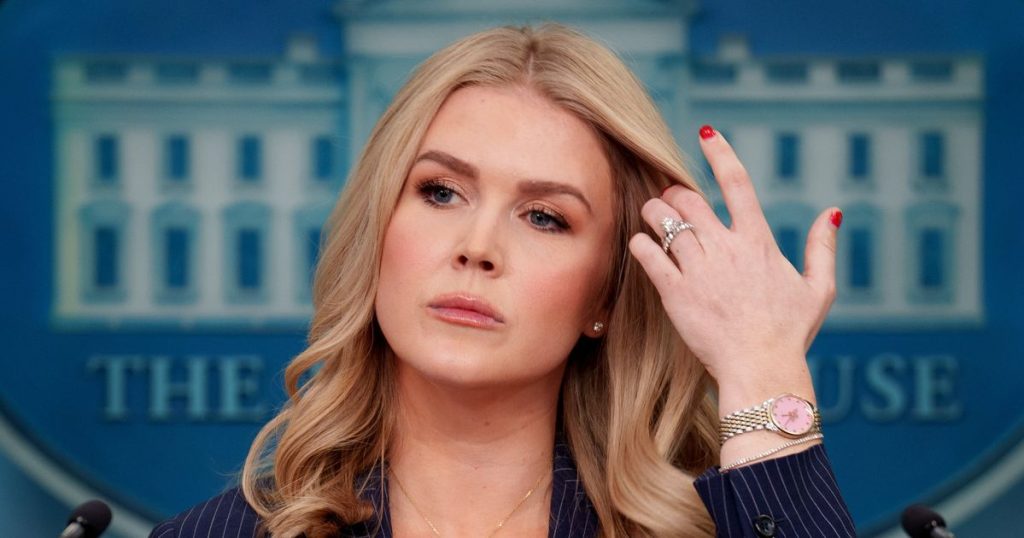White House Press Secretary Karoline Leavitt sparked a heated debate during her Wednesday briefing when she falsely claimed that the federal judiciary, not President Donald Trump and his billionaire adviser Elon Musk, is responsible for the constitutional crisis unfolding in the United States. Her remarks reflect a misunderstanding of the fundamental principles of the U.S. Constitution, particularly the system of checks and balances established in 1789. The federal judiciary, as one of the three branches of government, is designed to act as a check on the executive branch, ensuring that no single branch oversteps its authority. This balance of power is a cornerstone of American democracy, and it is precisely this mechanism that allows the judiciary to challenge executive actions deemed unconstitutional or overreaching. However, Leavitt contended that the real constitutional crisis lies within the judiciary, accusing district court judges in “liberal courts” of abusing their power to block President Trump’s executive authority.
Leavitt’s argument hinges on the idea that the judiciary is undermining the will of the American people, who elected President Trump with 77 million votes. She criticized judges for issuing injunctions that temporarily block certain executive actions, calling these actions an “abuse of the rule of law” and an attempt to “thwart the will of the people.” While it is true that the judiciary has the power to delay the implementation of laws or executive orders while their constitutionality is reviewed, this authority is not a bastardization of democracy but a deliberate feature of the constitutional framework. Judges like John C. Coughenour of the Western District of Washington have exercised this power recently, temporarily blocking Trump’s order to end birthright citizenship, a right guaranteed by the 14th Amendment. Coughenour, appointed by Republican President Ronald Reagan, emphasized that the rule of law must remain a guiding principle, even when it stands in opposition to the president’s policy goals.
The judiciary’s role in reviewing executive actions is not a recent phenomenon but a long-standing aspect of American governance. Since Trump took office, he has signed an unprecedented number of executive orders, many of which have faced legal challenges. Judges have stepped in to evaluate whether these actions align with the Constitution, a responsibility enshrined in the separation of powers. While Leavitt portrays these judicial interventions as an overreach, they are, in fact, a necessary safeguard against unchecked executive authority. The Constitution explicitly guarantees that no one, including the president, is above the law, and the judiciary plays a crucial role in upholding this principle. By framing judicial oversight as a constitutional crisis, Leavitt and the White House are reframing legitimate checks on power as an existential threat to democracy.
Beyond the judiciary, legal scholars and elected officials have raised concerns about President Trump’s actions, particularly his attempts to influence federal spending and disregard constitutional boundaries. For instance, Trump’s recent actions against birthright citizenship, a fundamental right enshrined in the 14th Amendment, have drawn sharp criticism. His efforts to unilaterally alter this constitutional guarantee have been met with resistance, not only from the judiciary but also from legal experts who argue that such actions undermine the very foundations of the Constitution. Similarly, Trump’s approach to federal spending, which often bypasses congressional authorization, has been described as a direct challenge to the separation of powers. These actions, critics argue, represent a far greater threat to the constitutional order than any judicial intervention.
The broader debate over whether the U.S. is experiencing a constitutional crisis continues to escalate. Media outlets like The New York Times and The Atlantic have published articles suggesting that Trump’s actions have brought the country to the brink of such a crisis. Legal scholars, while not universally agreeing that a full-blown crisis has arrived, describe the current situation as a “constitutional stress test.” University of Virginia law professor Amanda Frost told NPR that the U.S. is enduring a period of significant strain on its constitutional framework, even if it has not yet reached a breaking point. This strain is exacerbated by the president’s apparent disregard for the rule of law and his willingness to act unilaterally, often in ways that defy clear constitutional limits.
Ultimately, the assertion that the judiciary is responsible for the constitutional crisis is a misdirection. The real concern lies in the executive branch’s growing disregard for constitutional norms and its attempts to consolidate power at the expense of the other branches of government. The judiciary’s role in reviewing executive actions is not an abuse of power but a fulfillment of its constitutional duty. By attacking the judiciary, Leavitt and the White House are not defending democracy but undermining the checks and balances that prevent any single branch of government from dominating the others. The true constitutional crisis, if it exists, is not in the courts but in the White House’s relentless push to erode the rule of law and disregard the limitations placed on the executive branch by the Constitution.
